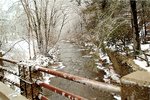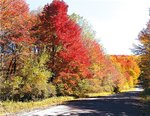Out here in the Northern Reaches of the Catskill Mountains, myths abound, but none has greater purchase than the one I call the sand/salt myth.
Ask most road department heads why they use a …
This item is available in full to subscribers.
Please log in to continue |



Out here in the Northern Reaches of the Catskill Mountains, myths abound, but none has greater purchase than the one I call the sand/salt myth.
Ask most road department heads why they use a combination of sand and salt on the back roads of so many small towns and the answer will be; “Sand is cheaper than salt”. Well, that seems like a logical reason, but so many myths start out sounding reasonable and then start falling apart when scrutinized even a little.
The salt/sand myth appears to make perfect sense; sand is less than one fifth the price of salt and most of us are willing to accept that as fact, and, that's the beauty of this particular myth. Buy cheap sand, the cheapest tires, or the cheapest paint, and you'll save money, the philosophy behind these myths.
Problem is, the cheapest tires won't hold the road as well, wear out quicker and tend to thump like crazy when the weather gets cold. The cheapest paint winds up taking more coats, will show more marks, and somehow never has the same finish. If you put no value on your time, or your life, cheapest may be the way for you to go.
Most of us who live at the higher elevations get to see slightly more snow since it's a bit colder and that tends to squeeze moisture out of the atmosphere most nights.
It falls almost light as goose down in the morning, seldom even an inch, and you can literally blow it off your car with a strong breath. However, each morning the town sends a monster up the road to go through the motions of plowing those feathers off the road.
The snow goes flying with little effort, yet for some reason that's never enough. The spreader on the back also swirls a combination of sand and salt. Enough remains that the next day the snow melts a little, justifying yet more sand and salt.
It gets worse with each subsequent snow, resulting in a wet combination of salt and sand that is picked up by the wheels of cars and trucks and is then distributed to the sides and undersides of our vehicles, where all the expensive mechanical stuff is.
Good old common sense can distinguish between myth and reality. No one with a black top driveway salts it before or during a snow, knowing the snow will melt, stick to the driveway and make the snow heavy and nearly impossible to fully remove since it usually turns to ice or slush. Common sense.
But common sense doesn't prevent the towns from dispatching truck after truck loaded with that salt/sand mixture during a snowstorm. It doesn't keep the State of New York from doing the exact same thing, the exception being that they use only salt.
The highways become covered in dangerous wet slush, the local roads become dangerous covered in sand and dirty slush. Salt is expensive, sand/salt is cheap, neither works well when used improperly. Salt/sand manages to be worse. Where the sand/salt myth is particularly glaring is that it's only cheaper to buy, not cheaper to use.
Sand doesn't melt snow, and the small amount of salt used to keep the sand from freezing in the truck only partially melts the snow on the roads. In fact, it is so ineffective, I've personally witnessed plow trucks making four, FOUR TRIPS!, to plow and sand three inches of snow. Common sense, once again, indicates if you can't make a snowball or a snowman, the snow is too dry to stick to itself or the roads.
If the road were simply plowed, with no sand or salt being applied, many trips could be eliminated and the roads would, actually be safer. After all, who pays their plow guy four times his usual rate to plow three inches of snow off their drive? Preposterous.
A judicious use of salt/sand will give us safer roads and far lower road department costs, money better spent keeping our roads in top shape. The heavy recent snows had plow trucks making six or more trips up my little road to plow and drop their sand/salt mix, and, the road is still not down to macadam, but it is covered in wet mud. My driveway was plowed in two trips and the snow was completely removed. Common sense prevailed.
The myth further states: sand provides grip. Odd, one thing my driving instructor back in high school stressed was to be careful of sand covered roads, since it keeps your wheels from making contact with the road and you can slip.
Well, after weeks of trucks spreading sand on my road, there is no macadam surface visible, the road is completely covered with sandy mud, and it's getting worse every day. In spring sand piles in many unexpected places and creates unwanted surprises.
Yet another characteristic of sand: it doesn't dissolve like salt, however, it does help plate the mechanical parts of cars and trucks with a highly corrosive layer of sand/salt which stays wet for days, or longer, accelerating the damage, rotting shocks, brake shoes, rotors and calipers, fenders, bumpers, aluminum parts and the supporting frame itself. It takes above freezing temperatures and some mighty rains to wash that fine sand off roadways and off the bottom of our vehicles.
We're back to cheap versus good. The towns may be claiming to spend less money, but you won't be, and any repair is more costly since mechanics often have to deal with bolts and nuts rusted together. To a man, they point to salt/sand as the culprit.
Trucks and cars continue to become more expensive, yet within a few years this environment can devalue them considerably. Dealers know to look underneath to see how damaged your trade in is.
We are then often left to choose between ever-escalating replacement costs, or expensive repairs.
Each year there are people and machines on the back roads of many Sullivan County towns digging up sand that has washed from the roads and filled the drainage ditches alongside. It's not possible to calculate these costs as a lay person, but observing all those people, trucks and machines operating for weeks at a time, a safe guess is that it's very expensive.
Add those costs to that of sand and you no longer have a cheap product, but one whose costs grow dramatically. Just as buying cheap paint, and cheap tires, buying this supposedly cheap snow treatment has its down sides.
There is yet another consideration: much has been said about the growing resort industry resurgence and it's long overdue, but the people who drive up from the city are usually driving nice automobiles, clean on the outside, clean on the inside. Sullivan County sends them home covered with dirt outside, inside, and underneath.
They drip all that wet sand into their parking garages, while their cars look disgusting. It's doubtful visitors factored in a complete expensive detailing job when they drove up, and it becomes questionable whether they will make additional trips again in the winter no matter how much they like it here.
And lastly, there are endless references to this being a storied trout fishing area. There is a well appointed hatchery capable of producing thousands of healthy well-fed brown trout of moderate size which could further enhance that reputation.
However, in spring, these fish are unceremoniously dumped into local streams which are themselves running brown from all the sand that has washed in and which has provided a coating over virtually all the little creatures that the trout need to eat to survive.
Essentially, they either starve from lack of food, or die choked by the sand and salt. Not a pretty picture but unfortunately too realistic, and it's the final cost of sand/salt usage.
Whether it's dead fish, extensive damage to cars and trucks from rust, or money being wasted unnecessarily, the use of a salt/sand combination is not the low cost option we have all been led to believe and it is a myth that needs to be laid to rest.
Comments
No comments on this item Please log in to comment by clicking here